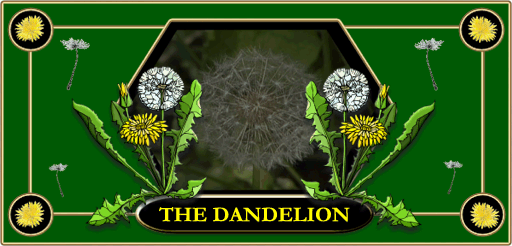
Ah, the dear old dandelion, the dear old dandelion that as a youngster featured so heavily in the daily routine. Hardly a day went by when handfuls of dandelion leaves weren’t gathered for the pet rabbit. As the year progressed the foraging trips got longer and longer as the hedgerows were stripped and the rabbit’s appetite became more voracious. That sodding rabbit, our old man swore blind he bought it at the pet shop but I’m sure it was a wild one, the scratches and bites I got from that thing should have been reported to the child protection agency. In fact come to think about it, if it was a bit lighter I would now say it was a hare.
Then the dreaded day would come when Granfer decided that it was time to make the dandelion wine. We were dispatched to pick bucketfuls of dandelion flowers and the old boy always insisted these must be gathered between 10.00am and noon. Yeah, I can still picture the brown stained hands that had to be scraped clean with a pumice stone. Yeah, I can still recall that bitter taste that coated your mouth should you be remiss enough to stick a un-pumiced digit into its depths. I can also remember spending back-breaking hours bent double over the lawn digging out the dandelions that were thoughtless enough to root themselves in that hallowed turf. Every mumping dandelion had to be uprooted before it formed its seed head or else we got hang – – bloody dandelions!
On the other hand I can remember walking through summery hay meadows with the heat haze shimmering and the air filled with dandelion seeds gently wafting in the moorland breeze. They always reminded me of an airborne invasion of parachutists silently drifting down to their objective – romantic or what. Sometimes we would have contests to see how long you could keep a seed in the air by blowing at it – ah, dandelions.
It is supposed that the name dandelion derives from the French name for the plant, namely, ‘dents-de-lion’. This refers to the fact that the serrated leaves resemble lions teeth. The dear old dandelion went by various names such as the ‘Milky Dashle’ and my favourite, the ‘Piss yer Bed’. That one I really liked because you could ‘swear’ in front of your aunts without getting whacked. The name alludes to the old superstition that any child who picked a dandelion would end up wetting the bed before the day is out. As always there is some truth in this as the young leaves when eaten act as a bladder stimulant, indeed for centuries this property led to the plant being used in a treatment for cystitis.
Whilst on the subject of cures the dandelion has also be used in the treatment of warts and spots, in this case the milk from the stem would be directly applied to the offending blemish.
The leaves of the dandelion were sometimes added to salads or lightly boiled and served as a green side dish. Occasionally some folk would make ‘coffee’ from the roots of the plant which is said to prevent constipation, the other benefit of this beverage is that unlike proper coffee it is not a stimulant. I have only tried it once, healthy but tastes very much the same as sucking a wet blanket that belonged to a child who picked a dandelion that day.
The dandelion has also been used for telling the time in various ways, firstly if you take a full seed head and then count the number of puffs it takes to blow off all the seeds then this equates to the hour of day. This is an old belief and one that was in use before the advent of the 24 hour clock. If the theory was applied to the 24 hour clock it would never be any later than noon as I have never seen any seed head that lasts longer than 12 puffs. Alternatively it is said that the flower head always opens at 5.00am and closes at 8.00pm which in many cases coincided with a farmers working day.
This handy little plant also acted as a weather forecaster because it was believed that if the flower head closed in the middle of the day then there would be rain by nightfall. Or similarly if the seeds dropped off when there was no breeze to blow them off rain was on its way.
Some folks will tell you that if you think of a loved one and then blow the seeds off the dandelions clock then they will carry those thoughts to them. There is also the belief on some parts of the moor that if dandelion flowers are picked on midsummer’s eve and kept in the house or byre they will protect both people and animals from witchcraft. For protection against the ‘evil eye‘ it was advised to wear a dandelion picked on midsummer’s eve in ones lapel or bonnet. If a mother wanted to know how much her child would grow over the coming year then she must go out on midsummer’s day and pick the longest dandelion she could find. Next, the stem must be measured and however many inches it was would equate to the number of inches the child would grow over the next 12 months. Heaven knows why one should, but if a person dreamt of a dandelion then it was a sure sign that bad luck was on its way in some shape or other.

As mentioned above, the old boy used to make dandelion wine and this is the time honoured ritual that he used:
Firstly take a young child and at 10.00am on a sunny morning give them a plastic bucket and pack them off down the hedgerows with strict instructions not to return until the bucket is full of dandelion flowers.
Secondly, on their return, which should be roughly 2 hours later, make the child sit in the garden and pull all the petals of each flower head. This process must continue until they have filled 4 pint mugs. Then give the unfortunate child a pumice stone and tell them to scrub their stained hands and not to come back until they are clean. When said child returns two hours later give them 6d for all their efforts – yeah, thanks old feller.
Retire to the kitchen and place a gallon of water into a large pan and set to boil on the Aga, when bubbling like a witches cauldron remove from the heat.
Next put the 4 pints of dandelion petals into a basin and pour the boiling water over them and then cover the basin with one of mother’s finest tea towels and leave to steep for 2 days.
Then return the liquid to the pan and bring to the boil, add the peel of 4 oranges and boil for a further 10 minutes. Having done that put 3lbs of granulated sugar into a crock and then strain the liquid through a muslim cloth onto the sugar, stir until completely dissolved.
When cool add the juice from the 4 oranges, oops did I forget to say to save the fruit once the peel of the oranges has been removed – bugger. Add one teaspoon of yeast and one teaspoon of malt extract and pour into a fermentation jar.
When completely fermented, ie when the jar stops gurgling like a bullock with bloat, and the wine is clear place the jar on the table and a row of bottles on the floor. Take a length of tube, rinse thoroughly to get the remnants of the red diesel out of it and siphon the wine from the jar into the bottles, trying not to kick the full bottles over in the process. When all the bottles are full lightly shove a cork in each one and place in a warm, quiet room for 2 months.
After 2 months remove the bottles from the quiet room and re-siphon the wine once more. I think this process is called racking but I have never heard of a farmer ‘racking’ the red diesel out of his wife’s car when he knows the inspectors are about. Once the wine has been re-bottled place it back in the quiet room for at least 6 months.
The longer you can resist opening the wine the better it will taste, some say it must lay for at least a year but I can’t remember any staying uncorked that long. Conversely don’t be tempted to open the wine within the six months, Granfer did and he spent ages in the carsy with the Western Morning News, and he wasn’t reading it.
 Legendary Dartmoor The many aspects past and present of Dartmoor
Legendary Dartmoor The many aspects past and present of Dartmoor
